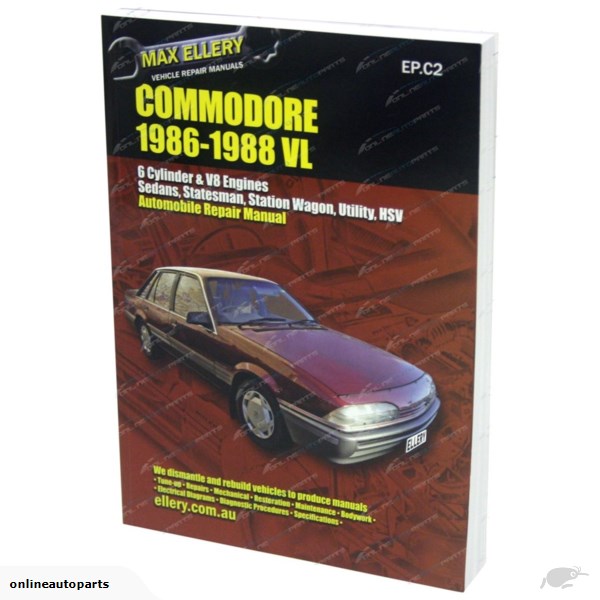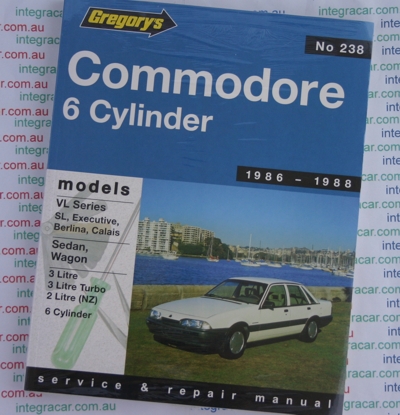Holden Commodore VL 6 cyl 1986 1988 Gregorys Service Repair Manual
Holden Commodore VL Series Gregorys Owners Service and Repair Manual 1986-1988NEW paperbackOther Holden Car Repair Manuals click hereOther Commodore Repair Manuals click hereGet the Ellery VL Commodore repair manual (covers the V8) click hereHolden Commodore VL (6 cyl) 1986 - 1988 Gregorys Owners Service & Repair Manual Covers VL series SL, Executive, Berlina and Calais, sedan and wagon. Engines Covered: Please note: It DOES NOT cover the V8 engine. Covers everything you need to know, step by step procedures, hundreds of photographs and illustrations, routine maintenance, wiring diagrams, repairs and overhauls, and what tools to buy. Gregory's manuals are based on an actual vehicle stripdown and are researched and written by automotive engineers with vast experience.
|
The Holden VL Commodore and Calais were a personal choice of mid-sized cars manufactured between 1986 and 1988 by way of the General Motors (GM) Australian arm, Holden. The VL wheel of time was the final update belonging to the first generation Holden Commodore architecture, heralding imported straight-six engines from Nissan of Japan. The VL Commodore represented a substantial makeover associated with the VK, and would be the last of the mid-size Commodores. The engineers sought to soften the lines belonging to the VL, rounding off the panels and introducing a small tail spoiler already a part of the boot lid. To get the VL, Holden implemented rectangular headlamps unlike the square-type fitted to earlier models. For any of the top-of-the-range Calais model, the design and style incorporated having semi-retracting headlight covers, the very first to have a production Holden. This appeared to be previously attempted found on the never released Torana GTR-X which featured fully retractable headlights. Interestingly the Calais covered headlights that have been identical to the totally normal VL Commodore headlights. Major changes were which is designed to the dashboard with new instruments, touch switches mounted either side controlling wipers, rear window demister, electric antenna (Berlina/Calais), and therefore the headlight switch moved because of the right-hand dash side in direction of the indicator stalk. Heating, ventilation, and air-conditioning control graphics changed slightly, the center console offered more storage with new transmission shifter and surround.
Straight-six engine
A comprehensive makeover for all the VK Black engine was completely dropped to be replaced by an imported 3.0 litre RB30E straight-six unit designed and manufactured by Nissan in Japan. This featured an overhead camshaft (OHC) as well as an alloy cylinder head. The true reason for the Nissan-Holden combination was because all cars manufactured in Australia from 1 January 1986 been required to are operated with unleaded 91 octane fuel. The previous six-cylinder Black motor was unable to do that, as was the V8, hence the later release date of this engine. Due to the tooling to get a Holden straight-six engine had become worn written by this stage, aside from that it was not considered cost-effective to adapt the design and style to unleaded petrol. As an alternative to engines included features for example , an Electronic Combustion Control System (ECCS) in addition to a ram-tuned intake manifold.
A few months into its to push out a 150 kilowatts (200 hp) turbocharged RB30ET version belonging to the Nissan engine was released. The Garrett turbo unit was fitted in a very very water-cooled housing to make certain that longevity. The engine received new pistons which lowered the compression ratio, while an updated camshaft was used to slim down overlap. The allure belonging to the Commodore was quickly established particularly when the top speed was 200 kilometers per hour (124 mph) and then extended to 220 kilometres per hour (137 mph) because of the addition of the Garret turbocharger. Aside from that stopping power for all the turbo models was upgraded to larger brakes and Girlock finned alloy front calipers. The Australian Police commissioned the turbocharged models his or her "interceptor" Highway Pursuit cars of choice. These interceptors were denoted by "BT1" belonging to the model code located on the Body & Option plate connected to the firewall. GM also sourced a Nissan electronic four-speed automatic. The ones that opted for about a manual, received a Holden five-speed transmission, The New Zealand assembled six-cylinder VLs had the 2.0 litre Nissan RB20 engine six-cylinder for being an addition to the 3.0 litre models. The engine was mated because of the Japanese Jatco four-speed automatic; the 5.0 litre (4,987 cc) V8 remained that make up carbureted form while using the old three-speed automatic. New Zealand models decided not to have emission controls fitted.
Holden Commodore VL Series Gregorys Owners Service and Repair Manual 1986-1988 1987

 0 Items (Empty)
0 Items (Empty)













 >
>